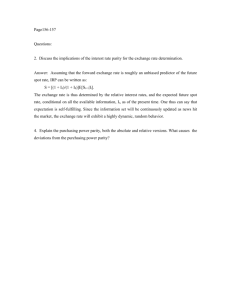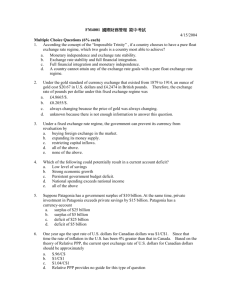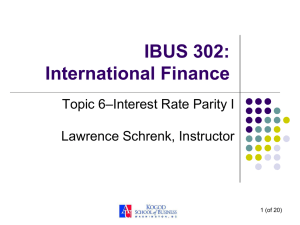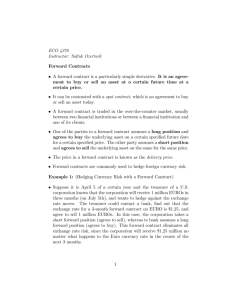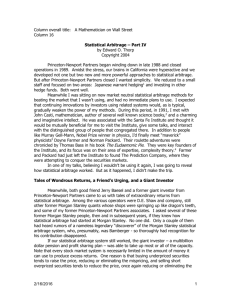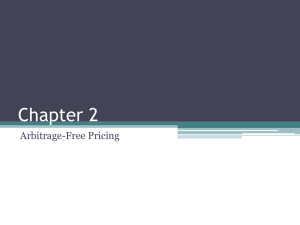International Arbitrage And Interest Rate Parity International
advertisement
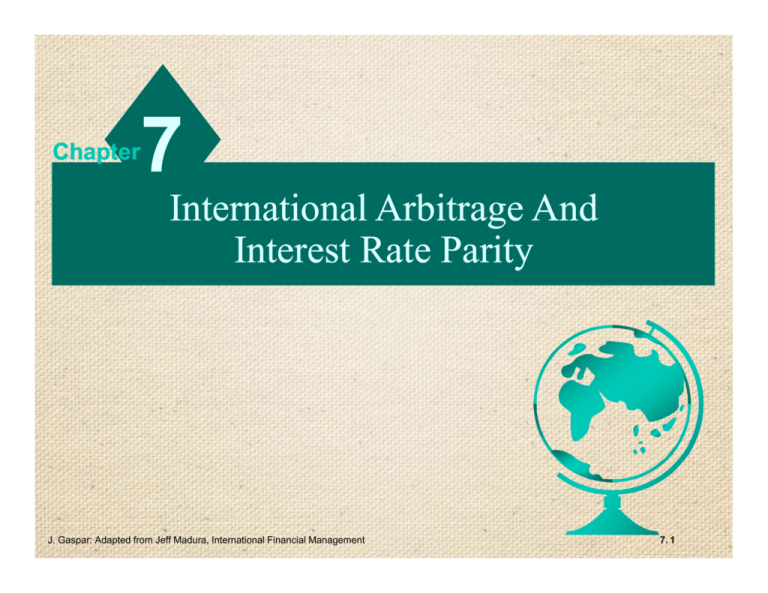
Chapter 7 International Arbitrage And Interest Rate Parity J. Gaspar: Adapted from Jeff Madura, International Financial Management 7. 1 Major International Finance Theories The objective of International Finance theories is to understand how and why, in a system of free markets and flexible exchange rate, currencies strive to move toward equilibrium. These theories define the relationship between exchange rates (current spot, future spot, and forward), inflation, and nominal interest rate movements. 7. 2 Theory One: Interest Rate Parity (IRP) According to IRP, at equilibrium, the forward rate of a foreign currency will differ (in %) from the current spot rate by an amount that will equal the interest rate differential (in%) between the home and foreign country. However, before one proceeds to discuss IRP, the concept of currency arbitrage needs to be explored first. 7. 3 Chapter Objectives To explain the conditions that will result in various forms of currency arbitrage, along with the currency realignments that will occur in response; and To explain the concept of interest rate parity, and how it prevents foreign exchange arbitrage opportunities. 7. 4 International Arbitrage • Arbitrage can be defined as capitalizing on a discrepancy in quoted prices to make a risk-free profit. • The effect of arbitrage on demand and supply is to cause prices to realign, such that risk-free profit is no longer feasible. • International Arbitragers play a critical role in facilitating exchange rate equilibrium. They try to earn a risk-free profit whenever there is exchange rate disequilibrium. 7. 5 International Arbitrage • As applied to foreign exchange and international money markets, international arbitrage (i.e., taking risk-free positions by buying and selling currencies simultaneously) takes three major forms: • locational arbitrage • triangular arbitrage • covered interest arbitrage 7. 6 Locational Arbitrage • Locational arbitragers try to offset spot bid-ask exchange rate disequilibrium • Locational arbitrage is possible when a bank’s buying price (bid price) is higher than another bank’s selling price (ask price) for the same currency. Example Bank C Bid Ask Bank D Bid Ask NZ$ $.635 $.640 NZ$ $.645 $.650 Buy NZ$ from Bank C @ $.640, and sell it to Bank D @ $.645. Profit = $.005/NZ$. 7. 7 Triangular Arbitrage • Triangular arbitragers try to offset cross-rate disequilibrium • Triangular arbitrage is possible when a cross exchange rate (exchange rate between two foreign currencies) quoted by a bank differs from the rate calculated from dollar-based spot rate quotes. Example Bid Ask Bank A: British pound (£) $1.60 $1.61 Bank B: Malaysian ringgit (MYR) $.200 $.201 Bank C: British pound (£) MYR8.10 MYR8.20 Calculated cross rate (A/B) £ MYR8.00 MYR8.01 7. 8 Conducting Triangular Arbitrage • Cross rates (£/MYR) are in disequilibrium and there is room for risk-free profit if the American arbitrager had access to £ • Challenges: US arbitragers do not (1) have £, and (2) calculated cross rates are not quoted by banks • Example: Let’s assume that the US arbitrager has $10,000 to invest in deal and let’s see how much profit could be made. 7. 9 Profit from Triangular Arbitrage • Sell $10,000 and buy £ from Bank A = $10,000 ÷ 1.61 = £6,211 • Sell £6,211 to buy MYR at Bank C = £6,211 x 8.10 = MYR50,309 • Sell MYR50,309 to buy $ at Bank B = MYR50,309 x 0.20 = $10,062 • Triangular arbitrage profit = $10,062 - $10,000 = $62 or ($62/$10,000)x100= 0.62% 7. 10 Triangular Arbitrage US$ Value of £ in $ £ Value of MYR in $ MYR Value of £ in MYR • When the actual and calculated cross exchange rates differ, triangular arbitrage will force them back into equilibrium. 7. 11 Covered Interest Arbitrage • Covered interest arbitrage is the process of capitalizing on the interest rate differential (on assets of similar risk and maturity) between two countries while covering for exchange rate risk. • Covered interest arbitrage tends to force a relationship between forward rate premium or discount (difference between the forward and spot rate) and interest rate differentials. 7. 12 Covered Interest Arbitrage Example £ spot rate = 90-day forward rate = $1.60 U.S. 90-day interest rate = 2% U.K. 90-day interest rate = 4% Borrow $ at 3%, or use existing funds which are earning interest at 2%. Convert $ to £ at $1.60/£ and engage in a 90-day forward contract to sell £ at $1.60/£. Lend £ at 4%. Note: Profits are not achieved instantaneously. 7. 13 Comparing Arbitrage Strategies Locational : Arbitrage Capitalizes on discrepancies in exchange rates across locations. $/£ quote by Bank X $/£ quote by Bank Y 7. 14 Comparing Arbitrage Strategies Triangular : Arbitrage Capitalizes on discrepancies in cross exchange rates. €/£ quote by Bank A $/£ quote by Bank B $/€ quote by Bank C 7. 15 Comparing Arbitrage Strategies Covered Interest : Arbitrage Capitalizes on discrepancies between the forward rate and the interest rate differential. Forward rate of £ quoted in dollars Differential between U.S. and British interest rates 7. 16 Comparing Arbitrage Strategies • Any discrepancy will trigger arbitrage, which will then eliminate the discrepancy, thus making the foreign exchange market more orderly. 7. 17 Interest Rate Parity (IRP) • As a result of market forces, the forward rate differs from the spot rate by an amount that sufficiently offsets the interest rate differential between two currencies. • Then, covered interest arbitrage is no longer feasible, and the equilibrium state achieved is referred to as interest rate parity (IRP). 7. 18 Derivation of IRP • When IRP exists, the rate of return achieved from covered interest arbitrage should equal the rate of return available in the home country. • End-value of a $1 investment in covered interest arbitrage = (1/S) (1+iF) F = (1/S) (1+iF) [S (1+p)] = (1+iF) (1+p) where p is the forward premium. 7. 19 Derivation of IRP • End-value of a $1 investment in the home country = 1 + iH • Equating the two and rearranging terms: (1+iF) (1+p) = 1 + iH p = (1+iH) (1+iF) –1 i.e. forward premium = (1 + home interest rate) (1 + foreign interest rate) –1 7. 20 Determining the Forward Premium Example • Suppose 6-month ipeso = 6%, i$ = 5%. • From the U.S. investor’s perspective, forward premium = (1.05/1.06) – 1 - .0094 • If spot rate, S = $.10/peso, then 6-month forward rate = S (1 + p) .10 (1 _ .0094) $.09906/peso 7. 21 Determining the Forward Premium • The IRP relationship can be rewritten as follows: F–S S = S(1+p) – S S =p= (1+iH) (1+iF) –1= (iH–iF) (1+iF) • The approximated form, p iH – iF, provides a reasonable estimate when the interest rate differential is small. 7. 22 Graphic Analysis of Interest Rate Parity Interest Rate Differential (%) home interest rate – foreign interest rate 4 2 Forward Discount of FC (%) -3 Y IRP line Z B 1 -1 X 3 Forward Premium of FC(%) -2 A W -4 7. 23 Graphic Analysis of Interest Rate Parity Interest Rate Differential (%) home interest rate – foreign interest rate 4 Zone of potential covered interest IRP line arbitrage by 2 foreign investors Forward Discount of FC (%) -3 -1 1 3 Forward Premium of FC (%) -2 -4 Zone of potential covered interest arbitrage by local investors 7. 24 Test for the Existence of IRP • To test whether IRP exists, collect actual interest rate differentials (assets of similar risk and maturity) and forward premiums/discounts for various currencies, and plot them on a graph. • IRP holds when covered interest arbitrage is not possible or worthwhile. 7. 25 Interpretation of IRP • When IRP exists, it does not mean that both local and foreign investors will earn the same returns. • What it means is that investors cannot use covered interest arbitrage to achieve higher returns than those achievable in their respective home countries. 7. 26 Does IRP Hold? Forward Rate Premiums and Interest Rate Differentials for Seven Currencies 7. 27 Does IRP Hold? • Various empirical studies indicate that IRP generally holds. • While there are deviations from IRP, they are often not large enough to make covered interest arbitrage worthwhile. • This is due to the characteristics of foreign investments, such as transaction costs, political risk, and differential tax laws. 7. 28 Considerations When Assessing IRP Transaction Costs iH – iF Zone of potential covered interest arbitrage by foreign investors Zone where covered interest arbitrage is not feasible due to transaction costs IRP line p Zone of potential covered interest arbitrage by local investors 7. 29 Considerations When Assessing IRP Political Risk • A crisis in a country could cause its government to restrict capital outflow and impose exchange controls (exchange of the local currency for reserve currencies). • Investors may also perceive a higher default risk on foreign investments. Differential Tax Laws • If tax laws vary, after-tax returns should be considered instead of before-tax returns. 7. 30 Changes in Forward Premiums

